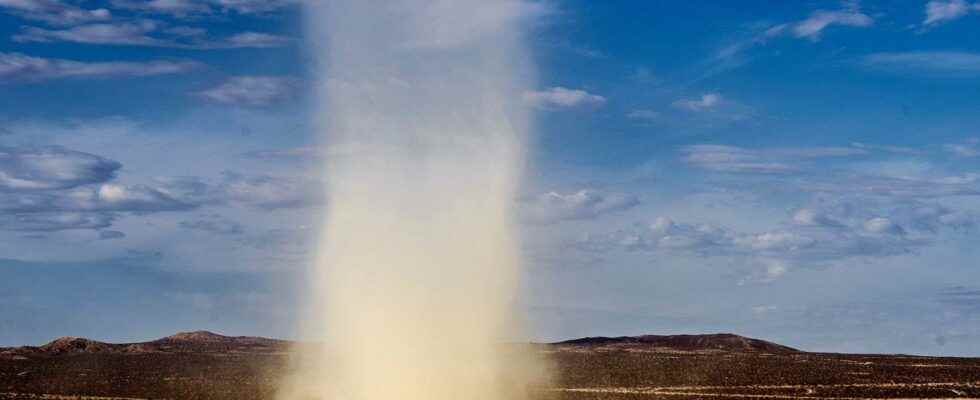During hot summer days, it happens that a whirlpool, sometimes impressive, suddenly forms before disappearing as quickly: it is the Dust Devil, or whirlwind of dust in French.
You may also be interested
[EN VIDÉO] A powerful tornado recreated by computer Concerned by the hundreds of tornadoes that plague the central United States each year, researchers there are trying to better understand how these devastating monsters form. Scientists have reconstructed with a supercomputer the “El Reno” tornado, one of the most powerful ever observed, which hit Oklahoma on May 24, 2011. It destroyed everything in its path over more than 100 km for nearly two hours… Thanks With this simulation, we better identify the phenomena at work.
The Dust Devils, or “Dust Devils”, were so named by American Indians who believed in a manifestation of Evil. They are also known as “Witches” in some regions of France and Quebec, or ” Willy Willies” in Australia. They form very commonly in dry weather in desert regions in spring and summer: fromair very dry and unstable rotates and raises dust or sand of the ground. In addition to a very hot ground, it is necessary to have an area with a temperature difference nearby: a lawn or a forest, for example, which brings a little freshness.
Warm air from the ground will meet cooler air nearby and this will create convection : this instability will generate the rotation of a whirlwind more or less big. Their diameter most often varies from a few centimeters to a few tens of meters. Their formation depends strongly on the warming of the ground and they are therefore more likely to occur during the very long days around the summer solstice at the end of the afternoon.
The Dust Devil is not a tornado
Often confused with a tornado, the Dust Devil is a very special phenomenon that does not occur under the same conditions: all vortex phenomena are not tornadoes. A tornado forms under a thunderstormit is in fact an outgrowth of the storm cloud, the cumulonimbus. The Dust Devil forms completely independently, under clear blue skies, in calm weather. Most dust devils cause no damage or casualties, and weaken on the first obstacles encountered (houses, cars…).
A very large Dust Devil during a football match in Bolivia. © Inside Edition
Some people even have fun going through it, a behavior that is still better avoided because the whirlpool can transport debris: this debris (pebbles, pieces of wood or objects for example) swirl around speed and can cause serious injury.
Tornadoes, on the other hand, come in a wide variety of intensities: they can sometimes be as weak as some Dust Devils, but can also be devastating with winds whirling at 200 or 300 km/h, a level that the Dust Devils do not reach. Dust Devils are also very short-lived, a few seconds to a few minutes, while the most violent tornadoes can have a duration life of up to one hour. How to tell the Dust Devil from a tornado on the first hiteye ? Nothing could be simpler: a whirlwind transparent under a big clear blue sky is a Dust Devil, a dark gray whirlwind under a dark stormy sky is a tornado.
The Dust Devil can generate electricity
The dust devils have a surprising particularity: the most powerful of them go so far as to produce electric shocks. By rubbing against each other, dust particles simply create static electricity. The same electrical phenomenon is found in volcanic ash clouds. The Dust Devils can also be the starting point for a tornado of fireif they form with the hot air of a fire and meet the flames.
Dust Devils are very common phenomena on Earth in spring and summer, and occur mostly in desert regions (american desert, Australia, North Africa), but also in the harvested fields of France. But it is not just a phenomenon specific to our Planet! Dust Devils have already been filmed on Marsalso in desert conditions.
Interested in what you just read?
